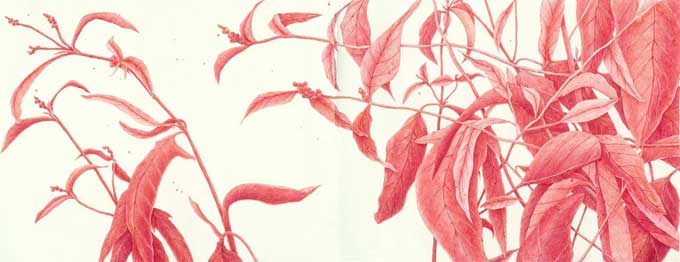Next story: Celebrating Stephen McKinley Henderson
Nature shown victorious in exhibit at Nina Freudenheim Gallery
by Jack Foran



Resilient Beauty
Looking at Joan Linder’s exquisite artwork currently on show at the Nina Freudenheim Gallery, I think of the line of the poem by Gerard Manley Hopkins: “When weeds in wheels shoot long and lovely and lush.”
The poem is about spring. The phenomena of spring. Humble and magnificent. Weeds and thrush’s eggs, the song of the thrush, tree leaves, blossoms. “All in a rush with richness.”
Weeds, grasses, pebbles, the earth underneath it all, are Linder’s phenomena. Humble and magnificent. Similarly “in a rush with richness.”
Pen and ink drawings on paper, somewhat oversize—the paper and the depicted weeds and grasses and such—in muted earth tones. A green like the green of emerging new plant life, before the sun has deepened and darkened it.
Hopkins’ poem is about spring as a glimpse into the original garden. “A strain of the earth’s sweet being in the beginning/ in Eden garden.” About the eternal loss of which Hopkins has no illusions. But in the face of that loss, he is saying, still there is spring.
Neither does Linder have illusions about the garden—in a secular sense, but not that the distinction is all that significant—we have lost. Or more precisely, destroyed.
Another part of the current show is a glass case containing some smaller drawings of two different types. Long foldout drawings of the fenced-off roadside areas along River Road between North Tonawanda and the LaSalle section of Niagara Falls. That is, the Love Canal area.
The other type are what appear to be historical documents—all relating to regional problematic environmental matters—but are actually meticulous drawings of the represented documents. You have to look twice and look closely to see that they are drawings. Artifacts in a double sense.
They include a waste shipments manifest from Hooker Chemical Company files—probably a trial exhibit from the Love Canal litigation—listing substantial amounts of nuclear materials shipped to Hooker from facilities the likes of the Hanford nuclear production complex in the State of Washington, Knolls Atomic Power Laboratory in upstate New York, and Argonne National Laboratory, near Chicago; a letter about industrial effluent overflows to surface waters in North Tonawanda; a Courier-Express article about toxic materials dumping in Niagara County, and Niagara Gazette article about a concept for increased garbage dumping; a Department of Energy report—or at least the report cover, complete with ring coffee cup stain—entitled Human Radiation Studies: Remembering the Early Years, a transcription of an interview with radiation biologist Marvin Goldman, Ph.D.; and a map of hazardous waste dump sites in New York State by assembly districts. Fly-speck-size dots indicate dump sites. Everybody gets some—every assembly district—but in the zone along the Niagara River from northern Erie County into Niagara Falls, the black dots coalesce into what looks like an inky thumb print.
No illusions about what we have lost—destroyed—of the once completely glorious natural environment. That’s in the glass case. But what the main artworks seem to say—the weeds and such drawings is—in Gerard Manley Hopkins words again, from another of his poems—that “nature is never spent;/ There lives the dearest freshness deep down things...”
The Joan Linder exhibit continues through April 29.
blog comments powered by Disqus|
Issue Navigation> Issue Index > v14n14 (Week of Thursday, April 9) > Nature shown victorious in exhibit at Nina Freudenheim Gallery This Week's Issue • Artvoice Daily • Artvoice TV • Events Calendar • Classifieds |









 Current Issue
Current Issue